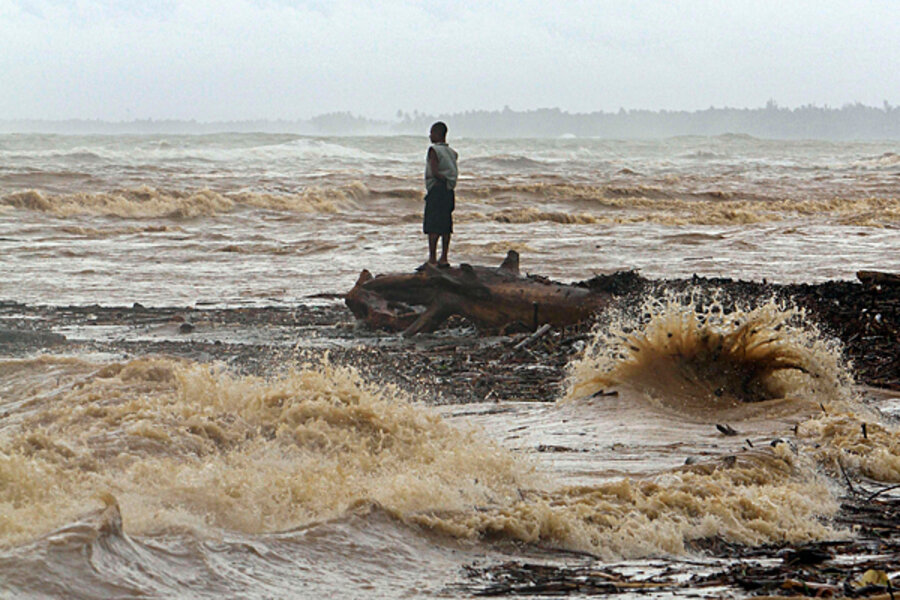The beach: sun, sand, and inequality in the Dominican Republic
Loading...
| Santo Domingo, Dominican Republic
In a country renowned for idyllic Caribbean beaches, crews were busy last week spreading sand around potted palm trees and temporary swimming pools on one of this city’s busiest avenues. A 1,000-foot stretch of the seaside George Washington Avenue, known locally as el malecón, was transformed into an urban beach, complete with lounge chairs, beach umbrellas, and volleyball nets.
Santo Domingo Mayor Roberto Salcedo said the four-day installation provided a free excursion for residents too poor to travel to a real beach over Easter weekend, one of the country’s busiest travel periods. By Sunday, some 230,000 Dominicans visited.
The concept of trucking in sand to create an artificial beach for city dwellers dates back years and has been tried from Mexico City, which has 10 of them, to Paris, which drew 2.3 million people to its first urban beach in 2002.
While popular, the ersatz beaches also serve as a reminder of the inequality that prohibits lower-income residents from traveling to parts of their own countries that are routinely visited by foreigners, even in a developing country like the Dominican Republic.
“The beach is [a] very political tool – and used simplistically and thus effectively in demonstrating the ‘us versus them’ debate,” says Dorothea Meyer, director of the Tourism and Poverty Reduction Research Unit at the Sheffield Business School in the UK.
Ms. Meyer, who has studied tourism in the Dominican Republic, says an urban beach may win political points – Dominicans will elect a new president this year – but it does little to tear down animosity between locals and foreigners.
Tourist destination
The Dominican Republic, once better known as a sugar producer, has become the Caribbean’s most visited destination by offering everything from cheap all-inclusive resort stays to some of the world’s best beach hotels.
In 1980, fewer than 400,000 tourists visited the country. Last year, a record 4.3 million foreigners came through its airports.
Along the way, the Dominican Republic developed an infrastructure for tourism, building eight international airports, toll highways, and 67,000 hotel rooms in hotspots like Punta Cana.
That translated into economic growth, as well. Last year, the Dominican economy grew by 4.5 percent after expanding by 7.8 percent in 2010, according to the central bank.
Today, tourism supports some 250,000 direct and indirect jobs and tourists spend upwards of $4.5 billion a year, according to statistics from the Tourism Ministry.
“Tourism is clearly the mainstay of the DR economy – thus ideally it should benefit the nation,” Meyer says. “Whether the spending filters down is obviously a very different issue.”
The tourism – local disconnect
Part of the problem is that much of the billions a year tourists spend in the developing world does not remain in the local economy.
On average, only 45 cents of every dollar a tourist spends in a developing country remains in the local economy. The rest is lost to the cost of imports and as profits to foreign-owned companies in a process termed “leakage.” Studies have found that leakage is even worse in the Caribbean, where only 25 cents of each dollar are retained. Spanish hoteliers own many of the most popular Dominican chains.
A 2006 World Bank economic report found that the “enclave” model of Dominican tourism limited the interaction between tourists and locals. The government and industry have tried to address that by developing tourism “clusters” in which local businesses, hotel owners and related industries, like agriculture, work together to share in the profits.
Still, about one of three Dominicans lives in poverty, according to World Bank statistics. The electricity cuts out daily and the country spends less of its gross domestic product on education than nearly any other Latin American country.
The festive Easter holiday, when students receive a week off school, many offices close, temperatures rise, and the beach calls, used to be a time for locals to get away.
“We used to take a guagua [bus] to the beach, but not for a long time have we gone during Easter,” says Eusebio Soto, a father of four who spent two days at the artificial beach.
At Boca Chica, a beach near Santo Domingo that Mr. Soto used to frequent, the 221-room Don Juan Beach Resort reported full capacity for the weekend. It raised its prices to $85 per night from $55 per night for food, drink and a room with an ocean view.
The resort, a budget option that normally caters to Dominicans, drew “mostly foreigners,” says Marta Flores, a sales representative. “It’s our busiest time.”
Back in Santo Domingo, children lined up to climb into one of the 12 above ground swimming pools. Some wore bathing suits. Others pulled up shorts so oversized they could have come from their father’s closet. A few boys stood self-consciously in boxer shorts.
“Everything costs more for Easter week: transportation, food, hotels. It’s too expensive to go to the beach, so you stay home,” says Jhonatan Cano, standing in front of a palm tree, sipping on a plastic bottle of Presidente beer.
Behind him, the blue-green Caribbean waters and cloudless sky that beckon millions of tourists each year created a picturesque backdrop. While the adjacent Playa Güibia, the city’s only public beach, sat closed for Easter weekend because it was too dangerous for swimmers.
“At least we have a beach this year,” Mr. Cano says. “A beach of pools.”
Get daily or weekly updates from CSMonitor.com delivered to your inbox. Sign up today.







